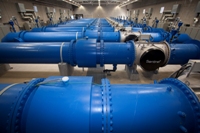The team’s analysis—published in a recent issue of Science magazine’s Policy Forum—is the first study of global tuna and billfish populations using the methods of the International Union for Conservation of Nature (IUCN).
In a settlement valued at more than $1.7 million, Clean Harbors of Braintree Inc. has agreed to pay a significant penalty and perform additional projects, to settle a complaint filed by the U.S. Department of Justice on behalf of EPA, regarding numerous violations of hazardous waste management and emergency planning laws at the company’s Braintree, Mass., facility.
Recent data from NSF-funded research in both Greenland and Antarctica demonstrate that fossil-fuel related emissions of both methane and ethane, two of the most abundant hydrocarbons in the atmosphere, declined at the end of the twentieth century, according to a paper published Thursday in the journal Nature.
The U.S. Environmental Protection Agency (EPA) is inviting small businesses, governments, and not-for-profit organizations to participate as small entity representatives (SERs) for a small business advocacy review (SBAR) panel.
Consider the apple core. From an environmental perspective, what’s the most responsible way to dispose of it, or a banana peel, or any food waste?
People are swimming in the Hudson again, and while clumps of sewage rarely float by anymore, the water is not reliably clean, according to a recent report released from the environmental group Riverkeeper.
World financial markets may be reeling from new setbacks, but it turns out there’s a secret economy right under our noses and it’s thriving. The movers and shakers, however, are plants and fungi.
Scientists from the U.S. Geological Survey will embark on a research cruise to the Arctic Ocean beginning today to collect water samples and other data to determine trends in ocean acidification from the least explored ocean in the world.

With a capacity of treating 315 million gallons of water per day, this new $114 million ultraviolet water treatment facility is now the largest-capacity facility of its kind in California and the third largest in North America.
the Smithsonian’s National Museum of the American Indian launches a new educational website, “American Indian Responses to Environmental Challenges,” that will target middle and high school teachers, students and the general public.
These findings point to climate change and variability working together equally to accelerate the observed sea ice loss during the late 20th century.
Rice University engineering researchers unveiled a new method for rapidly converting simple glucose into biofuels and petrochemical substitutes
The study, say the authors, will help to conserve some of the world’s most important coral reefs by identifying reef systems where biodiversity is high and stress is low, ecosystems where management has the best chance of success.
High concentrations of phosphorus in aquatic ecosystems are often associated with human activities in the surrounding area, such as agriculture and urban development.
The playground at Bristol Park in Turlock, Calif., is roughly 20 years old, in major need of a facelift and some TLC.
Under the terms of a settlement lodged in federal court, the City of Newport has agreed to eliminate illegal discharges of sewage into Narragansett Bay from its wastewater treatment plant and wastewater collection system.
Farmers in the Everglades Agricultural Area (EAA), south of Lake Okeechobee, achieved a record-setting 79 percent phosphorus reduction in the water leaving the farming region -- more than three times less phosphorus than the state requirement.
The cash register receipts that people place near paper money in billfolds, purses and pockets has led to a worldwide contamination of paper money with a potentially toxic substance.
There are many different types of plants in grasslands around the world. According to a new analysis of plants in grassland ecosystems around the world, it turns out that most of those plant species are important.
Algae-based fuel is one of many options among the array of possible future energy sources. New University of Virginia research shows that while algae-based transportation fuels produce high energy output with minimal land use, their production could come with significant environmental burdens.